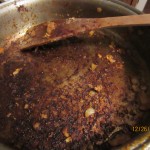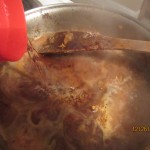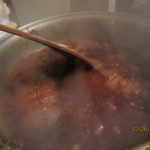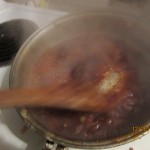- Browned bits. The lighting makes this looked burnt, but they weren’t.
- Add liquid
- Stir, loosen up those bits
- Reduce until syrupy
I love to deglaze my skillets. It might be the foodie in me, but it could also have something to do with being lazy and not wanting to scrape pans later. The idea behind deglazing is adding cold liquid to a hot skillet which will loosen all the brown, stuck-on bits from your pan or skillet. You would do this to make fantastic pan sauces for your meals because those brown bits hold tons of flavor. You could also do this if you are going to be making a roast or something – after browning the meat, if you do, deglaze the pan to loosen those brown bits before you put the meat in to roast. Doing this will add more flavor to the resulting drippings that forms from the roasting process (which you can then turn into a gravy). Those brown bits actually have a name, called fond but it sounds more sophisticated than I consider myself, so I will just stick with ‘brown bits.’
You can use a variety of liquids to deglaze, just decide what will be the best compliment to whatever you are making. In most cases, wine, broth, stock or juices like apple juice are great choices. I use White Zinfandel in almost EVERYTHING. I don’t like the taste of wine, but I like the taste of this wine after I have used it to deglaze a pan for a sauce or gravy. I substitute Sherry with this too. I use it with chicken and beef dishes. But different wines compliment certain meats better than others. Pick your preference.
Here is the lazy part of me coming out – if you deglaze a pan (even with water, if you don’t plan to use the brown bits) you won’t have to scrub those browned bits off later. If your pan us full of BURNED bits, depending on how bad you scorched the bottom I can’t guarantee deglazing will work. But I would try it anyway (and not use the resulting liquid….).
The Method
To deglaze a pan, you would brown or cook your meat as usual in it. I like to brown all sides of my roasts, and I like to pan-sear chicken or venison, and all of these leave browned bits. Remove your meat and drain off the fat. Put your skillet back over a high heat and prepare your deglazing liquid, whatever that may be. Keep it cold for best results. Pour it on the skillet and use a whisk to start whisking the brown bits up. It will immediately start to boil, lifting the bits up with the bubbles. It’ll work quick, so you can turn the heat down shortly thereafter to finish your sauce or gravy. Wine will steam and bubble like mad, so just prepare yourself for it as it can be startling and always add liquids that contain alcohol off the heat source.
A few tips…
- Make sure your pan is neither overcrowded (too small) or too big. If meat is too close together (closer than ¼ – ½ inch) the food will tend to steam instead of brown. And if it’s too far apart the bits may burn instead of just brown.
- Avoid cast iron if you plan to make pan sauces. I am a cast iron fan and cook nearly everything in it – but I try to remember to avoid browning meat in it when I know I will want to make a pan sauce. The reason for this is because cast iron can react with food at high temperatures and give it a metallic taste. Definitely don’t want that.
- Avoid nonstick skillets. The brown bits won’t stick and that makes it kind of pointless for this application.
- Use about a cup of liquid – this could be half wine, half stock, whatever combination you choose. Then reduce by half to make your pan sauce.
- To keep flavor balanced and fresh, deglaze your pan after each “batch” of meat, if you are doing more than one pan full. This will produce enough sauce for all of your meat, rather than deglazing the pan after you have cooked multiple batches and end up with less.
Now What?
So you have deglazed your pan. Now what do you do with it? Here are a few things you can get started with.
- If you are making a simple pan sauce, you would reduce the liquid by cooking it until it’s thickened by half (a good rule of thumb is to cook the liquid down until it coats a metal spoon), add some butter and serve. Simple pan sauces often have intense flavor because you have reduced all the flavors, so a tablespoon or two is about all you need per serving.
- A more complex sauce called a classic pan sauce takes just a few more minutes and adds new ingredients and depths of flavor. Finish cooking your meat, then up your heat to medium high, add some butter and quickly sautee some vegetables until they just begin to brown – onions or shallots, garlic, mushrooms, etc, before deglazing with your liquid of choice. Adding some herbs at the end, once the liquid has reduced can add additional flavor.
- Or, make a gravy.



